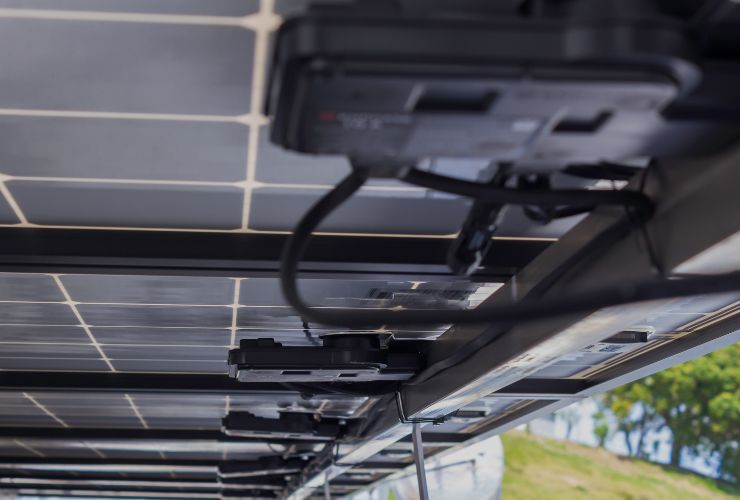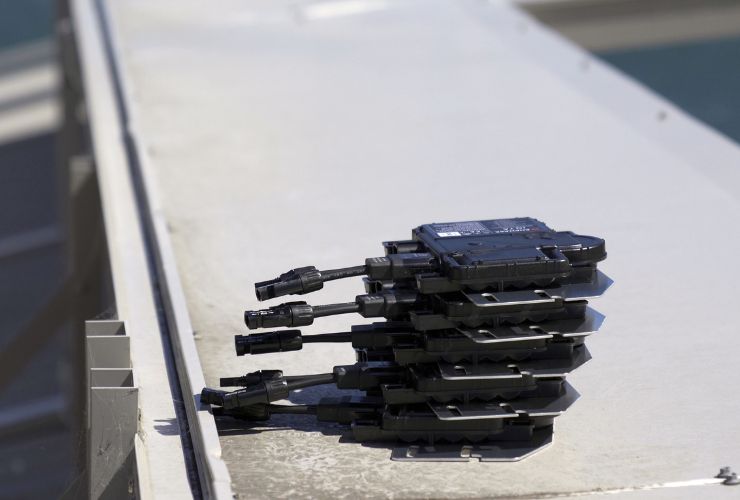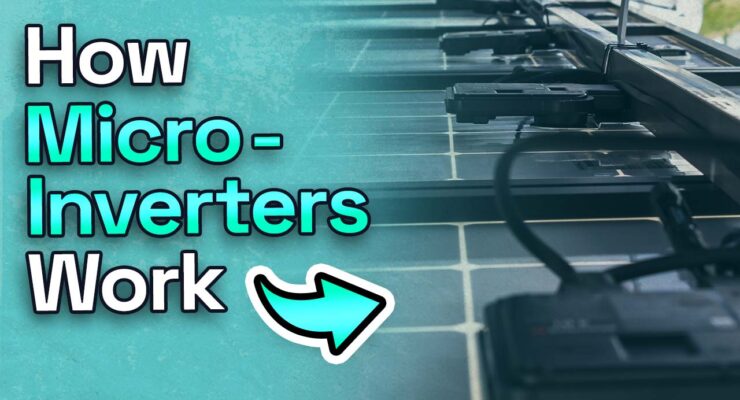Fast read
An inverter is an essential component of any solar PV system. Their role is to convert DC energy generated by solar panels into AC energy which your household appliances can use.
Two main options exist when selecting an inverter for your solar system. String inverters and microinverters. Microinverters are small electronic devices installed on each solar panel in a solar panel system.
They convert the solar panels' direct current (DC) electricity into alternating (AC) electricity. This can then be used in your home or business. Microinverters are extremely reliable and allow for panels to be monitored individually.
This allows homeowners to assess the performance of each individual panel rather than evaluating the system's performance as a whole. They can also allow solar systems installed on roofs with awkward angles or directions to perform efficiently still.
What is a microinverter and how do they work?
An inverter is an essential component of any solar system, and its role is to convert DC energy generated by solar panels into AC energy. Any inverter solution is a complex piece of electronics that continuously completes data monitoring, processing analytics and decision-making at a microsecond level. When selecting an inverter for your solar system, there are two main types, string inverters and microinverters. So what is a microinverter and how does it work?
Difference between microinverters and string inverters
String inverters are the original solar inverter technology that has been tested for many decades. Several or more solar panels (for residential, ideally 6 to 12) are connected in a string or series to a single inverter. The string inverter monitors, analyses and converts the combined power from the series or string of panels generated from DC to AC electricity.
Microinverters are inverters connected to every panel rather than a series of solar panels. The power from the single panel is converted in each solar panel unit from DC electricity to 230v AC electricity by the microinverter. This renewable electricity can then be used by the home straight away.
Microinverters operate at the solar panel site and are classified as module-level power electronics (MLPE). They can be used for more complicated solar installations and offer more flexibility in design than string inverters.
How does a microinverter work?
- The solar panel generates DC electricity: When sunlight hits the solar panel, it generates direct current electricity.
- The microinverter converts the DC electricity to AC electricity: It converts the DC electricity directly from the solar panel into AC electricity without DC cabling through the house. AC is the type of electricity that is used in homes and businesses.
- The AC electricity generated by the microinverter that cannot be used to power your home or business at the time will either be stored in a battery, a hot water tank or fed back into the power grid.
Microinverters vs String inverters?
If you have ever looked into solar as an option for your home, then you have heard of an inverter. An inverter is an essential component of any solar PV system, and its role is to convert DC energy generated by solar panels into AC energy. The AC electricity can then be used by your household appliances.
When selecting an inverter for your solar power system, there are two main options, string inverters and microinverters.

Advantages of a microinverter
1. Sizing
The wattage range of a solar panel that the microinverter can handle varies by model and should be matched with the wattage size of the panel. Microinverters also allow more flexibility in the sizing of the solar system to be installed. String inverters need a certain number of solar panels in a series to operate, so they may need several panels to work together.
Microinverters work individually so that systems can vary in size from many hundreds to as little as a single panel.
2. Individualisation
More flexibility in design and complete system sizing is achieved in individual solar panel increments rather than adding several solar panels. This also allows for panels to be monitored and managed for performance individually. Homeowners can quickly assess the performance of each solar panel rather than evaluate the system’s performance as a whole.
This also allows for more immediate fault find and equipment repair since it is easier to identify what component and which panel in the solar energy system is not performing to its best.
3. Benefiting different angled roofs
Microinverters can allow solar systems installed on roofs with small roof spaces, awkward angles or directions to perform efficiently still, as single solar panels can work independently and efficiently.
String inverters require several solar panels to face the same direction and be grouped and operated. Microinverter technology does not have this restriction. So they will not be affected by a generation issue on a single panel like a string inverter system would.
4. More flexibility
This technology allows for more flexibility when adding extra solar panels to your system in the future. Finding a solar panel wattage that matches your existing system a few years later is next to impossible.
This is because solar panel manufacturers change panel sizes and wattage every 3 to 6 months. Some manufacturers release up to 6 models and a range of watt classes in such short timespans. With microinverters, you do not have to worry about the power output of your additional panels changing.
Also, string inverters have a specific capacity, e.g. 5 kW. That means 6.6 kW of solar panels is the maximum allowed panel wattage to be combined with an inverter of that size.
In simple terms, the power of the inverter has been reached. If one would want a bigger system, then the inverter would need to be upgraded. Microinverters on the other hand can add more panels to an older system, as long as the local connection rules allow for a system capacity expansion.

5. Safety
Microinverters are considered a safer option than string inverters, and this is because they restrict the power to 230v AC being transported from the panels to the switchboard.
Whereas strings of solar panels see DC current, in many cases of 500v + passing through wires in the roof down to the single string inverter. The higher voltage DC power is more dangerous to humans as far as fire and potential electrocution risks are concerned.
6. Excellent monitoring
The monitor system for microinverters is extremely advanced and shows the output of every single solar panel. It is user-friendly and can be installed as an app on your phone, and overall it gives more info than many string inverter monitoring. It also gives you alert messages if something out of the ordinary is picked up by the sophisticated monitoring.
Potential disadvantages
1. Higher initial cost
A solar system with microinverters tends to be more expensive than a string inverter PV system on a per-panel basis. So they may not be the most cost-effective option for smaller cost-focused solar panel systems. This is especially true if your roof is straightforward with no shade issues no gables and varying angle complications.
However, some customers feel that the increased efficiency and performance of microinverters over time may outweigh the initial cost difference. Microinverters often are a good choice in shaded sites or awkward roof designs, resulting in excellent long-term bill savings.
2. Slightly lower efficiency
Individually microinverters tend to have a slightly lower rated efficiency than the best string inverters. However, they can overcome this through the efficiency gains of operating separately rather than in series. Some of the microinverters’ performance benefits could be limited in installations of large event spaces, e.g. commercial solar, where string inverters can work well.
3. More components and complexity
As there is an inverter under every solar panel, there are more components within a microinverter system. Argued that having more components increases the opportunity for components to fail, which could increase service costs and downtime overall. Nevertheless, the experience with Enphase microinverters and SolarEdge optimisers in Australia and NZ regarding warranty matters has been excellent, meaning issues are minimal.
Summary
Although microinverters are more expensive than string inverters upfront, the numerous benefits and more detailed, precise monitoring can outweigh the additional costs.
However, suppose you have a simple installation on a standard roof with no partial shading and allow solar panels to be installed at the optional angle and facing north or northwest. In that case, a simple string inverter technology will be a good option and provide long-term cost savings.



